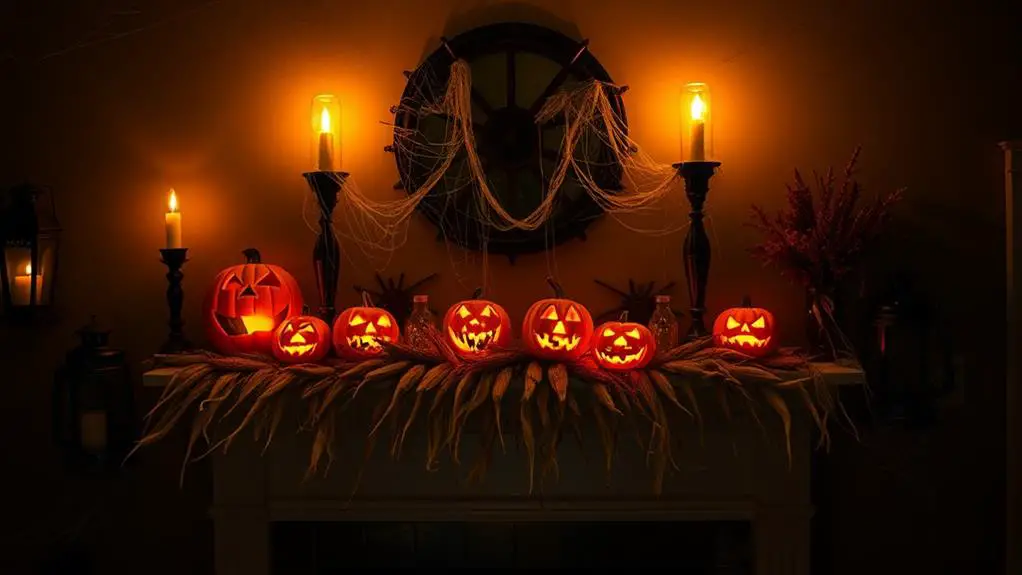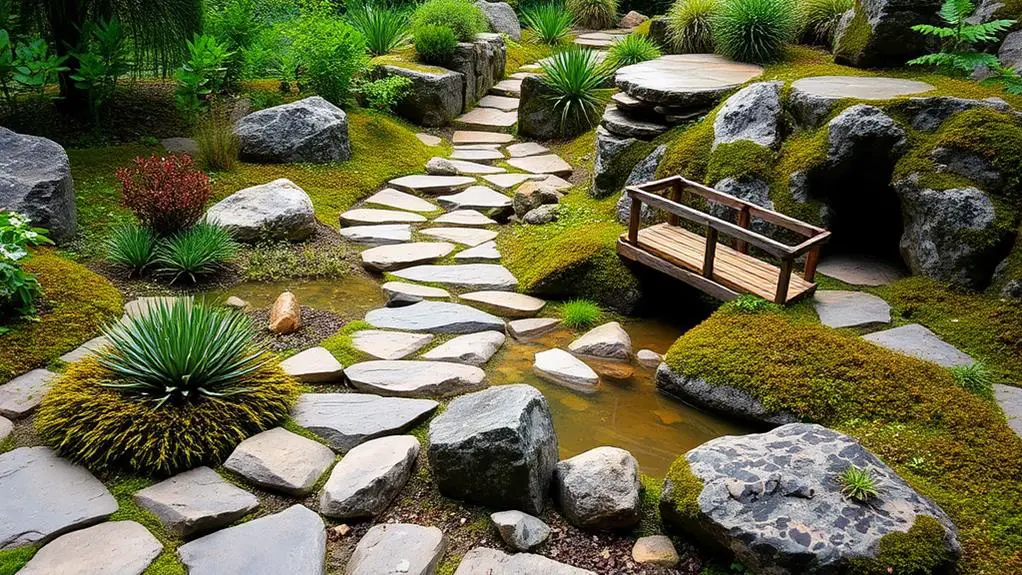As you step outside, you can't help but envision a serene retreat that mirrors your personal style. You're not alone – a thoughtfully designed landscape can elevate your home's curb appeal, create a sense of tranquility, and even increase its value. But where do you start? With so many options to choose from, it's easy to get overwhelmed. From statement plants that make a bold impression to water features that soothe the senses, the possibilities are endless. You're just one idea away from transforming your outdoor space into a haven that reflects your unique taste and style – so what's holding you back?
Curb Appeal Boosting Strategies

As you approach your home, the first impression is often the most lasting, making curb appeal a crucial aspect of home landscaping.
To boost your home's curb appeal, start by evaluating your front yard's layout and functionality.
Ponder front yard renovations that incorporate a mix of hardscapes, such as driveways, walkways, and patios, with softscapes like lawns, gardens, and trees.
A well-designed lawn makeover plan can greatly enhance your home's visual appeal.
When creating your lawn makeover plan, ponder the shape and size of your lawn, as well as the surrounding architecture.
Choose a palette of plants and materials that complement your home's style and color scheme.
Incorporate focal points, such as a statement entrance or a decorative water feature, to draw the eye and create visual interest.
Don't forget to ponder the functionality of your outdoor space, including outdoor lighting, seating areas, and storage solutions.
Statement Plants for Impact
Behind your home's façade, statement plants can bolster curb appeal and elevate your outdoor space into a stunning showstopper.
By strategically placing these show-stopping specimens, you can create a dramatic first impression that sets your home apart from the rest.
For a Desert Drama, consider incorporating drought-tolerant plants like agave, yucca, or Texas sage, which add a touch of rugged sophistication to your landscape.
Alternatively, transport your outdoor space to a tropical oasis with lush, vibrant plants like bird of paradise, palm trees, or hibiscus – perfect for creating a Tropical Treasure.
When selecting statement plants, don't be afraid to think outside the box and experiment with unique textures, colors, and forms.
Consider the mature size of the plant, its growth rate, and how it will interact with the surrounding landscape.
Water Features for Serenity

You've crafted a stunning outdoor space with statement plants, now it's time to take it to the next level by incorporating water features that evoke serenity.
Water features are a game-changer in outdoor design, as they create a sense of calm and tranquility.
To achieve this, ponder installing a tranquil pond, complete with a self-sustaining ecosystem and aquatic plants.
The gentle ripples on the water's surface will create a soothing atmosphere, perfect for relaxation.
For a more dramatic effect, ponder a cascading fountain.
The sound of water flowing over stone or concrete creates a mesmerizing melody that will transport you to a state of serenity.
You can also add LED lighting to enhance the visual appeal of your fountain, creating a stunning display of water and light.
When designing your water feature, don't forget to ponder the surrounding landscape.
Incorporate natural elements, such as rocks or boulders, to create a seamless shift between the water feature and the rest of your outdoor space.
Outdoor Kitchen Design Ideas
You're now ready to create an outdoor kitchen that's perfect for entertaining, and it starts with a well-designed kitchen island that provides ample counter space and storage for your outdoor cooking essentials.
Next, consider an outdoor dining area that's both functional and stylish, with a large table and comfortable seating for your guests.
To complete the space, don't forget to incorporate a grilling station with all the essentials, including a high-quality grill, countertops, and storage for utensils and seasonings.
Kitchen Island Designs
Three essential components of an outdoor kitchen design are functionality, aesthetics, and flow, and a well-designed kitchen island can expertly balance these elements.
You'll want to ponder the island shape that best suits your needs. Rectangular islands provide ample counter space and storage, while curved or L-shaped islands create a more dynamic flow.
Circular islands, on the other hand, can be a stylish focal point.
When selecting countertop materials, think about durability, maintenance, and style.
Natural stone, such as granite or bluestone, offers a sophisticated look and can withstand the elements. Concrete countertops provide a modern, industrial feel and can be customized with different finishes and colors.
You might also ponder recycled glass or porcelain for a sustainable, low-maintenance option. Whatever material you choose, verify it complements your outdoor kitchen's overall aesthetic.
Outdoor Dining Areas
Six key elements come together to create an inviting outdoor dining area: seating, tables, lighting, textiles, decor, and amenities.
You'll want to choose dining furniture that's both stylish and durable, able to withstand the elements. Consider a weather-resistant wicker or recycled plastic set, paired with plush cushions and pillows in a water-repellent fabric.
Tables can be made of natural stone, metal, or reclaimed wood, and should be sized to accommodate your seating and dining needs.
Lighting is vital for ambiance and safety, so install pathway lights, table lamps, or string lights to create a warm glow.
Textiles like outdoor rugs, throws, and placemats add color and texture to your space. When it comes to decor, you can incorporate outdoor art, sculptures, or planters to create visual interest.
Finally, amenities like umbrellas, heaters, or fire pits can extend your outdoor dining season and provide comfort during gatherings.
Grilling Station Essentials
As you design your outdoor kitchen, a grilling station becomes the central hub of culinary activity, where savory aromas waft and memorable meals are made.
To create an efficient and functional space, consider incorporating essential elements that elevate your grilling experience. Start by selecting a grill top that suits your cooking style, whether it's a gas, charcoal, or pellet-fueled model.
Next, add grill top accessories such as a grill grate, cutting board, and utensil holders to streamline food preparation and cooking.
A well-designed grilling station also requires thoughtful storage solutions.
Incorporate cabinets, drawers, or shelves to house cookbooks, seasonings, and cooking essentials. Station signage ideas, such as a chalkboard or a metal sign, can add a personal touch and create a sense of warmth.
Consider adding a built-in trash can, a sink, or a refrigerator to create a self-contained cooking space.
Fire Pit Gathering Spaces
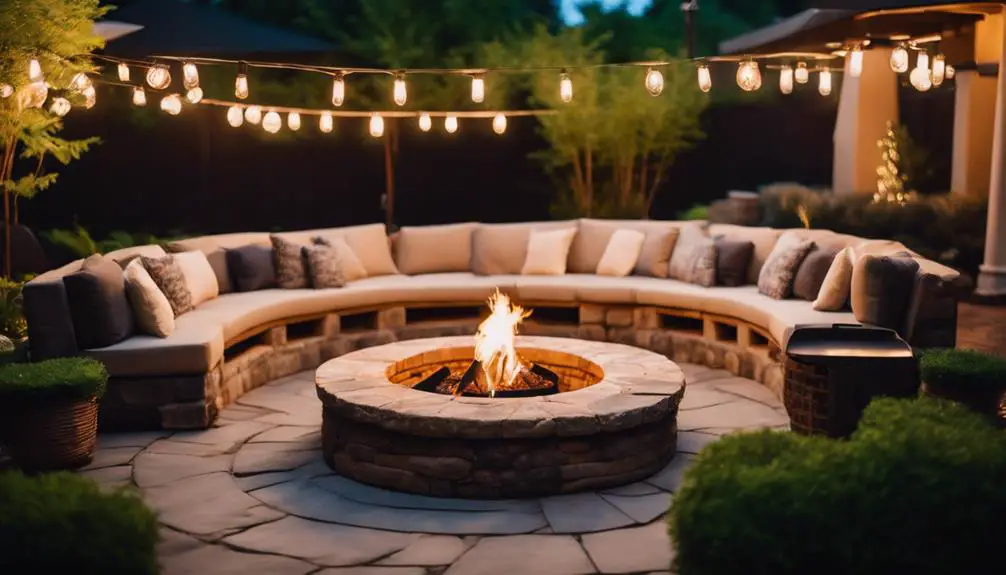
Your backyard becomes a warm and inviting haven when you create a fire pit gathering space that sparks conversation and connection.
To achieve this, focus on incorporating cozy seating arrangements that promote intimacy and comfort. Consider circular or U-shaped seating configurations that guide the flow of conversation towards the fire pit.
A fire chat area with built-in benches or a sectional sofa can create a sense of enclosure, making the space feel cozier.
When selecting materials, opt for durable, weather-resistant options like stone, brick, or concrete.
These materials can withstand the elements and create a natural, organic look that blends seamlessly with your backyard. To add ambiance, incorporate string lights or lanterns that cast a warm glow on the surrounding area.
Don't forget to incorporate a fire glass or lava rocks to add visual interest to the fire pit itself.
Private Retreat Creation Tips
You'll create a secluded ambiance by strategically positioning plants, trees, and structures to block views from neighboring properties and create a sense of enclosure.
To design a hidden oasis, consider incorporating screening elements like trellises, arbors, or pergolas, which can provide shade and seclusion while adding visual interest.
Secluded Ambiance Creation
Set boundaries with lush greenery and thoughtfully placed hardscapes to carve out a secluded ambiance in your outdoor space.
By strategically positioning plants, trees, and shrubs, you can create private nooks and cozy corners that feel shielded from the outside world. Consider using a mix of evergreen and deciduous plants to achieve a layered, dimensional look.
Incorporate natural stone or wood accents to add warmth and texture to your hardscapes.
To further enhance the sense of seclusion, incorporate vertical elements such as trellises, arbors, or pergolas. These structures can provide a sense of enclosure while still allowing natural light to filter through.
You can also use outdoor lighting to create pools of warmth and intimacy, drawing attention to specific areas of your private retreat.
Hidden Oasis Design
Transforming a corner of your yard into a hidden oasis requires careful planning and attention to detail.
You'll want to create an inviting atmosphere that draws you in and makes you want to linger. Start by designing an oasis entryway that sets the tone for your private retreat. Consider using a statement piece, like a large stone or wooden gate, to mark the entrance.
From there, create a secret pathway that winds its way through lush greenery, perhaps using natural stone or gravel underfoot. As you make your way down the path, the sounds of the outside world will begin to fade, replaced by the soothing sounds of nature.
To create an immersive experience, incorporate sensory elements like water features, fragrant plants, and soft lighting.
Consider adding a small pond or fountain to create a calming background noise, and plant fragrant flowers or herbs to engage your sense of smell. As the sun sets, string lights or lanterns can add a warm, inviting glow to your oasis.
Expanding Living Space Outdoors
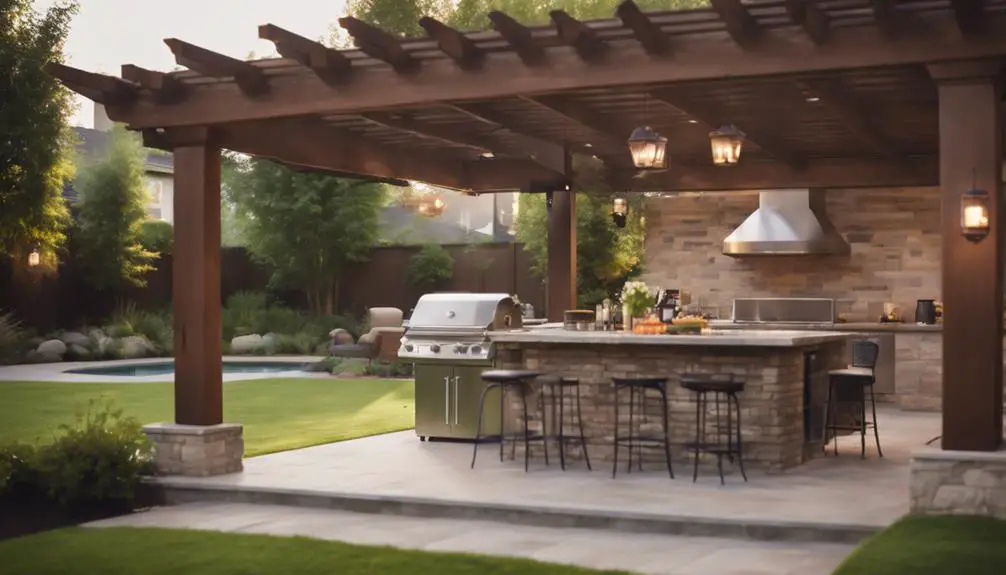
Expanding your outdoor living space means blurring the lines between indoors and outdoors, creating a seamless shift from one to the other.
You can achieve this by creating outdoor rooms that mirror the functionality and comfort of your indoor spaces. For instance, you can design an outdoor kitchen with a cooking station, dining area, and lounge seating, making it an extension of your indoor kitchen.
To create seamless passages, use materials and textures that complement your indoor design.
For example, if you have hardwood floors indoors, consider using the same material or a similar texture for your outdoor flooring. You can also use similar color schemes, furniture styles, and decorative elements to create a cohesive look.
Consider incorporating features like large sliding glass doors, retractable roofs, or walls that open up to the outdoors, allowing for an uninterrupted flow between spaces.
DIY Landscaping on a Budget
As you've successfully blurred the lines between your indoor and outdoor spaces, it's time to get creative with your landscaping without breaking the bank.
To achieve a stunning outdoor area on a budget, start by setting a realistic budget planning framework. Determine how much you're willing to spend and allocate funds to specific projects or areas of your yard.
Next, focus on material sourcing to find affordable alternatives to expensive materials. Consider repurposing items like old pallets, bricks, or stones to create unique features like planters, pathways, or walls.
You can also scour local classifieds or online marketplaces for discounted materials or second-hand items. Additionally, get creative with DIY projects like upcycling old furniture or turning mason jars into planters.
Hardscaping for Functionality
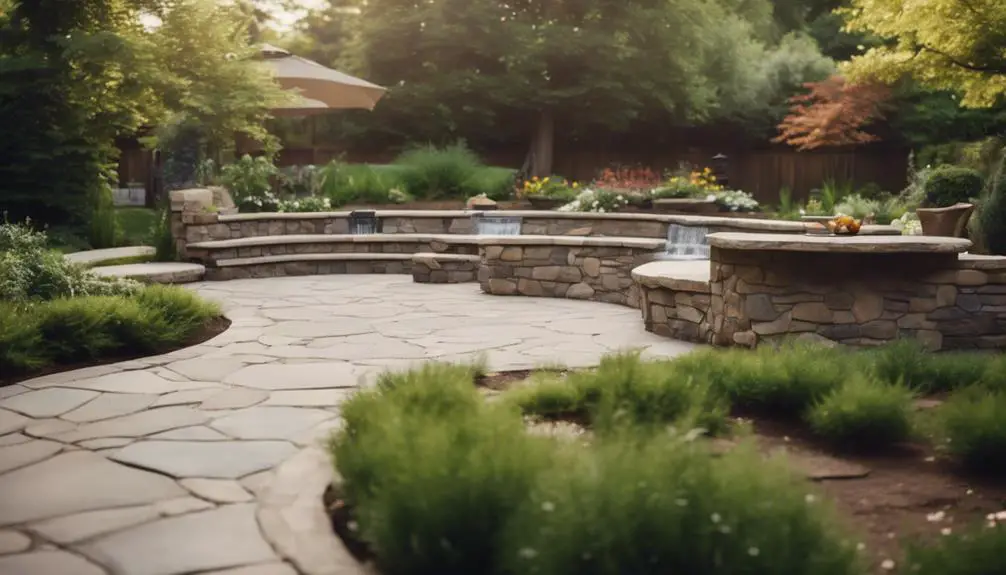
You'll want to ponder hardscaping elements that extend your outdoor living space, creating seamless shifts between indoor and outdoor areas.
By incorporating features like patios, walkways, and retaining walls, you can create functional spaces that flow smoothly from one to another.
This strategic use of hardscaping allows you to maximize your property's potential, turning previously underutilized areas into inviting spaces that beckon relaxation and entertainment.
Outdoor Living Extensions
Outdoor living extensions seamlessly merge your indoor and outdoor spaces, effectively increasing your home's functional square footage.
By creating a harmonious shift between your interior and exterior, you can enjoy a more expansive and connected living area. One way to achieve this is by designing outdoor lounges that flow effortlessly from your indoor living rooms.
These lounges can be created by installing large sliding glass doors, floor-to-ceiling windows, or retractable screens that blur the lines between indoors and outdoors.
To further enhance the functionality of your outdoor space, consider incorporating patio enclosures.
These enclosures can provide shelter from the elements, creating a cozy and inviting atmosphere perfect for relaxation or entertainment. By strategically positioning outdoor heaters, fire pits, or water features within these enclosures, you can extend your outdoor living season and make the most of your outdoor space.
Functional Space Creation
Through strategic hardscaping, you can carve out functional spaces within your yard, creating areas that serve specific purposes and enhance your overall outdoor experience.
By designing Functional Pathways, you're guiding visitors through your yard, creating an intuitive flow that leads to different zones. These pathways can be made of gravel, stone, or concrete, and can be lined with plants or lighting to create visual interest.
Purposeful Zoning is key to creating functional spaces. By dividing your yard into distinct areas, you can allocate spaces for different activities, such as dining, lounging, or gardening.
This zoning approach allows you to optimize each area for its intended use, incorporating features like built-in seating, fire pits, or outdoor kitchens. By incorporating functional elements, such as built-in planters or water features, you can create a cohesive and inviting outdoor space.
Lighting for Ambiance and Safety
Soft, warm glows and subtle highlights can transform your outdoor spaces, creating an inviting ambiance that beckons you to linger.
By strategically placing pathway lighting, you can create a sense of flow and direction, guiding visitors through your outdoor areas while highlighting key features like gardens, water features, or statues.
Moonlighting, a technique that involves placing lights high in trees or structures to mimic the soft glow of moonlight, adds an ethereal quality to your outdoor spaces.
This type of lighting creates a sense of depth and visual interest, making your outdoor areas feel larger and more expansive.
To guarantee safety, consider installing motion-sensitive lights in areas like stairways, walkways, and driveways.
Solar-powered lights are a great option for areas that receive ample sunlight, reducing your energy consumption and environmental impact.
Seasonal Decor Inspiration
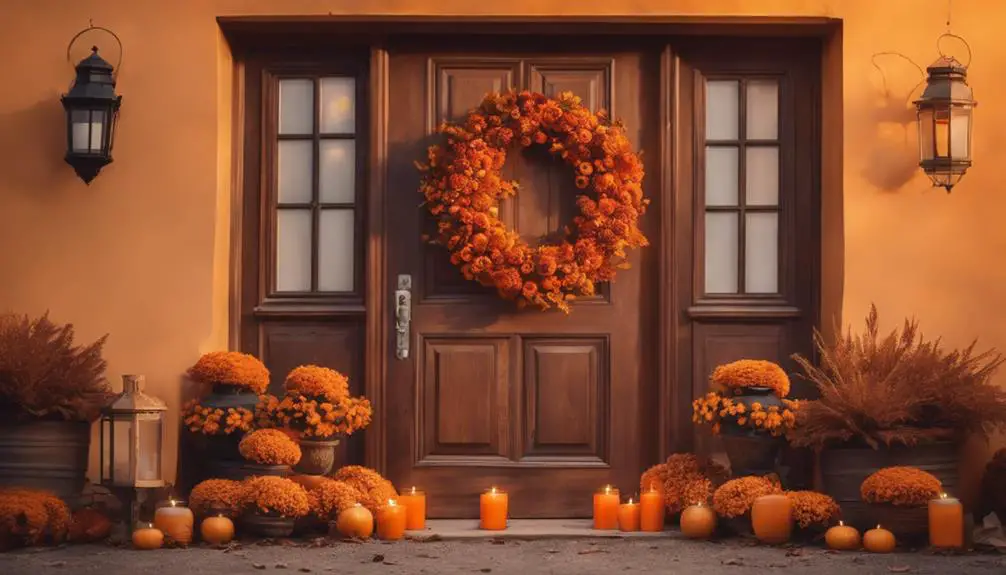
As you curate your outdoor space, incorporating seasonal decor can elevate its charm and character.
To create a cohesive look, start by selecting a color palette that complements your existing landscape features. For Winter Wonders, opt for icy blues and silvers, paired with warm whites and creams. This palette will create a serene, snow-kissed ambiance that invites cozy gatherings.
In contrast, Autumn Accents bring warmth and vibrancy with rich oranges, yellows, and reds. These hues will enhance the natural beauty of changing foliage, creating a cozy and inviting atmosphere.
Consider incorporating seasonal elements such as pinecones, branches, and pumpkins to add texture and depth to your decor.
Hang twinkling string lights or lanterns to create a magical ambiance in the evenings. Don't forget to incorporate scents like pine, cinnamon, or apple to further immerse your guests in the seasonal experience.
Eco-Friendly Landscaping Options
You're likely no stranger to the importance of eco-friendliness in modern living, and your outdoor space is no exception.
When it comes to eco-friendly landscaping options, you can make a significant impact by incorporating sustainable practices and materials into your design.
Start by selecting eco-friendly materials for your hardscapes, such as permeable pavers that allow rainwater to percolate through, reducing stormwater runoff.
Consider using recycled materials, like reclaimed wood or repurposed stone, to reduce waste and minimize the carbon footprint of your project.
Incorporate native plants and drought-tolerant species into your landscape to reduce water consumption and support local ecosystems.
Implement sustainable practices like rainwater harvesting and greywater reuse to minimize your water usage.
Additionally, consider integrating solar-powered lighting and irrigation systems to reduce your reliance on non-renewable energy sources.
Frequently Asked Questions
What Is the Best Type of Grass for Shady Areas?
When selecting grass for shady areas, you'll want to prioritize shade tolerance. Look for grasses with deep roots, like fine fescue or perennial ryegrass, which can thrive in low-light conditions, ensuring a lush, vibrant lawn that complements your outdoor space.
How Often Should I Prune My Trees and Shrubs?
You'll want to prune your trees and shrubs regularly, ideally every 2-3 years, to maintain their shape and promote healthy growth, using techniques like thinning, reducing, and heading to achieve a balanced, visually stunning landscape.
Can I Use Mulch on Top of Weed Barriers?
You can definitely use mulch on top of weed barriers, as it enhances aesthetics while boosting weed suppression; just guarantee the barrier is breathable, and the mulch layer is at least 2-3 inches thick for ideal results.
Do I Need to Fertilize My Plants in the Winter?
You shouldn't fertilize your plants in winter, as they're dormant, and excess nutrients can cause new growth, making them vulnerable to frost. Instead, focus on providing seasonal nutrients during active growth periods to promote healthy development.
How Do I Prevent Pests From Damaging My Garden?
You'll want to employ integrated pest control methods, combining physical barriers with organic deterrents like neem oil and diatomaceous earth to prevent pests from damaging your garden, while also maintaining a healthy ecosystem to minimize attractants.
Conclusion
As you step back to admire your transformed outdoor space, the harmonious blend of hardscapes and softscapes creates a breathtaking visual experience. Strategically placed statement plants draw the eye, while water features whisper serenity. Outdoor kitchens and fire pits invite gatherings, and private retreats offer secluded escapes. With carefully chosen lighting, seasonal decor, and eco-friendly options, your new oasis radiates warmth, functionality, and sustainability – a true reflection of your personal style.


